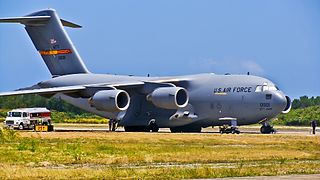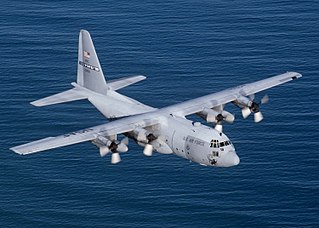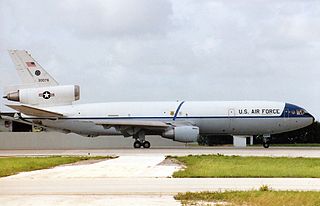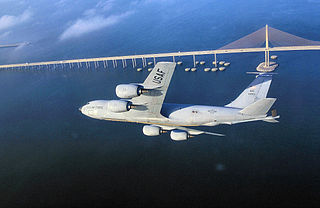
The 97th Air Mobility Wing is a United States Air Force (USAF) unit assigned to Nineteenth Air Force of Air Education and Training Command. It is stationed at Altus Air Force Base, Oklahoma. The wing is also the host unit at Altus. It plans and executes McDonnell Douglas C-17 Globemaster III, Boeing KC-46, and Boeing KC-135 Stratotanker pilot and aircrew training, providing formal school initial and advanced specialty training programs for up to 3,000 students annually. The training is done in a three-phase approach: Academic Phase, Simulator Phase, and Flying Phase.

The 376th Air Expeditionary Wing is an inactive wing of the United States Air Force. It was last stationed at the Transit Center at Manas International Airport, Kyrgyz Republic, supporting U.S. and ISAF operations in Afghanistan.

The 43rd Air Mobility Operations Group is an active duty air mobility unit at Pope Army Airfield, Fort Liberty, North Carolina and is part of the Air Mobility Command (AMC) under the USAF Expeditionary Center. The unit is composed of eight squadrons, including one of the only two active Air Force aeromedical evacuation squadrons based in the United States. The group's primary mission focuses on providing enroute operations and enabling global response and airborne support for Fort Liberty's 82nd Airborne Division.

The 92d Operations Group is the flying component of the 92d Air Refueling Wing, assigned to the United States Air Force Air Mobility Command Eighteenth Air Force. The group is stationed at Fairchild Air Force Base, Washington.

The 42nd Air Division was a unit of the United States Air Force. It was established as the 42 Bombardment Wing (Dive) on 8 February 1943. The wing first saw combat in September 1943. It was inactivated in 1991.

The 47th Air Division is an inactive United States Air Force unit. Its last assignment was with Strategic Air Command at Fairchild Air Force Base, Washington. It was inactivated on 27 February 1987.

The 301st Air Refueling Wing is an inactive unit of the United States Air Force being last assigned to the Strategic Air Command at Malmstrom Air Force Base, Montana, where it was inactivated on 1 June 1992.

The 32nd Air Refueling Squadron is part of the 305th Air Mobility Wing at Joint Base McGuire-Dix-Lakehurst, New Jersey. It operates the Boeing KC-46A Pegasus aircraft conducting air refueling missions. The squadron is one of the oldest in the United States Air Force, its origins dating to 19 May 1917, being organized at Camp Kelly, Texas. The squadron deployed to England as part of the American Expeditionary Force during World War I. During World War II, the squadron saw combat service as a Boeing B-17 Flying Fortress unit, assigned to the Fifteenth Air Force in Italy. During the early years of the Cold War, it was a Boeing RB-47 Stratojet strategic reconnaissance squadron as part of Strategic Air Command.

The 91st Air Refueling Squadron is part of the 6th Air Mobility Wing at MacDill Air Force Base, Florida. It operates the Boeing KC-135R Stratotanker aircraft conducting air refueling missions.

The 93rd Air Refueling Squadron is an active United States Air Force unit, stationed at Fairchild Air Force Base, Washington, where it is assigned to the 92nd Operations Group and operates the Boeing KC-135 Stratotanker aircraft conducting air refueling missions.

The 97th Air Refueling Squadron is an active unit of the United States Air Force, stationed at Fairchild Air Force Base, Washington. It was most recently activated on 1 October 2019 and assigned to the 92nd Operations Group, 92nd Air Refueling Wing.

The 307th Operations Group is an Air Reserve Component of the United States Air Force. It is assigned to the 307th Bomb Wing, Air Force Reserve Command, stationed at Barksdale Air Force Base, Louisiana.

The 97th Operations Group is a United States Air Force unit assigned to the 97th Air Mobility Wing of Air Education and Training Command. It is stationed at Altus Air Force Base, Oklahoma.

The 44th Fighter Group is an Air Reserve Component (ARC) unit of the United States Air Force. It is assigned to the Tenth Air Force, Air Force Reserve Command (AFRC), stationed at Tyndall Air Force Base, Florida. The 44 FG is an associate unit of the active duty 325th Fighter Wing of the Air Combat Command (ACC). If mobilized to active duty, the 44 FG is operationally gained by ACC. Otherwise, the 44 FG operates as a geographically separated unit (GSU) of AFRC's 301st Fighter Wing at NAS JRB Fort Worth, Texas.

The 98th Operations Group is a component unit of the Nevada Test and Training Range, assigned to the United States Air Force Air Combat Command. The group is stationed at Nellis Air Force Base, Nevada. It provides day-to-day control of the Nevada Test and Training Range (NTTR) and directly supports Air Force, joint and multi-national test and training activities; and operates two Air Combat Command bombing ranges; the NTTR and Leach Lake Tactics Range, near Barstow, California.

The 6th Operations Group is the operational flying component of the 6th Air Refueling Wing, stationed at MacDill Air Force Base, Florida.

The 28th Operations Group is the flying component of the United States Air Force 28th Bomb Wing, stationed at Ellsworth Air Force Base, South Dakota.

The 91st Operations Group is the operational component of the 91st Missile Wing, assigned to the Air Force Global Strike Command Twentieth Air Force. It is stationed at Minot Air Force Base, North Dakota.

The 98th Air Refueling Squadron is an inactive United States Air Force unit. Its last assignment was with the 92d Operations Group at Fairchild Air Force Base, Washington, where it was inactivated on 1 July 1998.

The 43d Air Refueling Squadron is an inactive United States Air Force unit. It was last assigned to the 92nd Bombardment Wing, stationed at Fairchild AFB, Washington. It was inactivated in 1995.


























